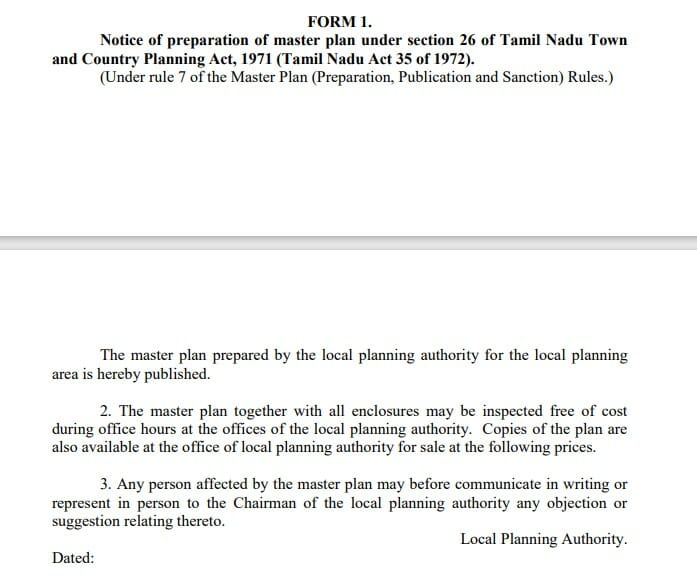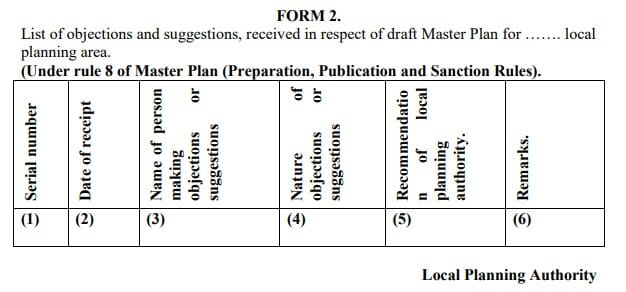The rapid urbanisation of Chennai calls for a better plan for the city’s growth. Master Plans play a crucial role in defining the direction of a city’s growth.
Chennai so far has seen two Master Plans. While the First Master Plan was intended to be in effect between 1976 and 2001, it lasted till August 2008. The Second Master Plan, which has been in effect since 2008, lasts till 2026.
The Chennai Metropolitan Development Authority (CMDA), has started the visioning exercise for the preparation of the Third Master Plan which will span from 2026 to 2046 for Chennai and has been conducting public consultations for the same.
It is pertinent to understand the process of preparation of the Master Plan for Chennai as it will enable greater participation by the residents.
What is a Master Plan?
According to CMDA’s definition, a Master Plan is a statutory document that outlines a city’s strategy and direction for its spatial, economic, social, and environmental growth. It creates a land-use plan which describes the type of development that is permitted in the given parcel of land. The preparation of the Master Plan for the Chennai Metropolitan Area (CMA), which is stipulated in the Tamil Nadu Town and Country Planning Act, 1971, extends over 1189 sq. km and comprises Chennai Corporation, 8 Municipalities, 11 Town Panchayats and 179 villages covered in 10 Panchayats Unions.
Read more: Shaping the future of Chennai through the Third Master Plan
Steps in Master Plan preparation for Chennai
Step 1: Vision Document
A Master Plan is a 20-year plan for a city’s growth. As a first step in the process of preparation of a Master Plan, a ‘vision document’ will be prepared which paves the direction for the preparation of the draft Master Plan for Chennai.
KP Subramanian, Professor of Urban Engineering at Anna University, points out that the visioning exercise was done in-house at the CMDA for the Second Master Plan.
“According to the Tamil Nadu Town and Country Planning Act, 1971, public opinion is sort only after the draft Master Plan is prepared. However, in a welcoming move the CMDA has been including public opinion from the visioning stage for the Third Master Plan,” he says.
Step 2: Sectoral assessment
The CMDA would then conduct surveys and collect data to analyse the current status of each sector including employment, housing, traffic and transportation, education, health and others. The data will be used for a qualitative and quantitative study of each sector of the existing population. Following this, an estimate of the future population (for the next 20 years) will be made.
“By comparing the shortage/surplus needs of the existing population with that of the estimated future population, the additional requirements for the future population in each of the sectors will be charted. Having quantified the requirements of the future population, it will be translated in terms of land use to meet these requirements,” explains Subramanian.
Step 3: Preparation of land and building use map
According to the government order on the Master Plan (Preparation, Publication and Sanction) Rules, a land and building use map has to be prepared within twelve months of the constitution of the local planning authority or within such further time as the Government may permit. Since the Second Master Plan for Chennai stands till 2026, Chennai is now at the stage of the visioning exercise.
Subramanian explains that the land use map is the legal document which describes the type of development that is permitted in the given parcel of land. “A developmental charge is levied on every planning permission submitted to CMDA. This is based on the change in land use. For instance, the developmental charge will be lesser when agricultural land is changed to residential land, in comparison to the change in land use from residential to commercial. This will be determined based on the land and building use map,” he says.
The predominant land and building use in the area includes (i) residential, (ii) commercial, (iii) industrial, (iv) public and semi-public, (v) transport, (vi) services and utilities, (vii) recreation, (viii) agriculture and (ix) other uses including undeveloped areas water bodies, waste and rocky lands.
Step 4: Preparation of draft Master Plan
Following the preparation of the land and building use map, the local planning authority, in consultation with the regional planning authority, local authorities concerned and the Director, will prepare and submit a draft Master Plan for the said area to the Government.
Step 5: Consent of Government
Within two months of the receipt of the draft Master Plan, the government will have to either give their consent to the local planning authority for the publication of notice of preparation of the Master Plan or direct the local planning authority to make modifications to the draft as they see fit.
Within three months after the return of the draft Master Plan from the Government or within a time frame prescribed by the Government, the local planning authority must make the modification if any and resubmit it through the Director.
The Government then gives its consent for the publication of notice of the preparation of the Master Plan within one month from the date of receipt of the modified plan from the local planning authority.
Step 6: Notice of preparation of draft Master Plan
Within 30 days of receiving the Government’s consent, the local planning authority publishes a notice of the preparation of the draft Master Plan, inviting objections from any person affected by or interested in the plan, within the period mentioned in Form 1.

Step 7: Receiving objections and suggestions
After the expiry of the period mentioned in the notice, the local planning authority sends in a list of objections and suggestions received together with remarks on the objections and suggestions to the Director for advice. The advice is then considered by the local planning authority.

Step 8: Meeting to consider the approval of the draft Master Plan
The local planning authority then convenes a meeting for considering approval of the draft Master Plan within 60 days from the date of expiry of the period mentioned in the notice. Before convening such a meeting, the local planning authority must ensure that a reasonable opportunity has been allowed for being heard by any person including representatives of Government departments and authorities who have made a request, Further, the objections and suggestions received in writing and the oral representatives made and also the advice, if any, received from the Director should also be considered. The plan is then approved with or without modifications as the local planning authority deems necessary.
Step 9: Submission of the draft Master Plan to the Government
The draft Master Plan as passed at such meeting is then submitted to the Government through the Director within three months or within a time frame permitted by the Government.
Read more: CMDA’s public consultation on Third Master Plan leaves little room for residents’ voices
Step 10: Approval of the Master Plan by the Government
Three months from the date of receipt of the draft Master Plan from the local planning authority, the Government either approves the Master Plan as is or approves it after modifications as they may consider necessary or returns the Master Plan to the local planning authority to modify the plan or the prepare a fresh plan as directed.
If the Government has ordered any material modification in the draft Master Plan, the local planning authority must carry out such modifications and resubmit the plan within three months.
In case the Government orders the preparation of a fresh plan, the local planning authority must prepare a fresh plan in accordance with such directions as may be given in this regard and submit it to Government after following the procedure and time limit prescribed in the rules.
The Government then accords approval to the plan and the approval is published.
Step 11: Republication of notification
Within one month of the publication of the notification in the Tamil Nadu Government Gazette, the local planning authority must republish the same in the manner prescribed in the rules.
All notifications by the local planning authority and republication of notices relating to the Master Plan published in the Tamil Nadu Government Gazette must be republished
1. in the District Gazette concerned;
2. on the notice board of the office of the local planning authority;
3. on the notice board of the office of the District Collectors concerned;
4. on the notice board of the office of the Regional Deputy Directors;
5. on the notice board of the local authorities comprised in the area; and
6. in one or more leading daily newspapers circulating in the local planning
area.
Step 12: Review of Master Plan
The Government can order a full review of the Master Plan. The Government may modify or revoke a Master Plan and any such variation or revocation shall be notified in the Tamil Nadu Government Gazette. Any variation or revocation of a Master Plan notified in the Tamil Nadu Government Gazette is also republished as per the existing rules.
At present, Chennai is at the very first step of the preparation of the Third Master Plan with the vision exercise and consultations on the same. The various components of the Master Plan have a direct impact on the daily lives of Chennaites. The plan will also serve as the north star for the city’s growth and development in the decades to come.
With the planning process initiated, it is vital for Chennaiites to keep tabs on recent developments, attend public consultations and share their suggestions and critiques to refine the Master Plan prior to it coming into effect in 2026.
Water, Water and Water conservation and preservation should be most important criteria for the master plan. Nothing more important in the whole world than water. Rain water harvesting, preserving and creating new water bodies, cleaning all water resources including rivers, ponds, lakes, etc, having proper water management system should be a top priority. Cooum being named as the most polluted river in the country is a serious blot to a city which is a pride to the nation in many ways. Rivers that could have facilitated for water transport and entertainment in addition to draining out storm water is now in ruins. Open space, parks playground and water bodies should be very important part of the master plan.